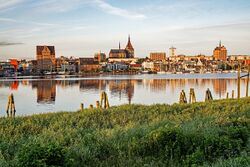Weisenburg: Difference between revisions
No edit summary |
mNo edit summary |
||
| Line 30: | Line 30: | ||
The city is governed as its own distinct entity within the United Principalities. It is governed by a Lord-Mayor (''Oberbürgermeister''), who is appointed by the King and confirmed by the [[Imperial Senate of the United Principalities|Imperial Senate]]. | The city is governed as its own distinct entity within the United Principalities. It is governed by a Lord-Mayor (''Oberbürgermeister''), who is appointed by the King and confirmed by the [[Imperial Senate of the United Principalities|Imperial Senate]]. | ||
The Öberburgermiester and the city council (Stadtrat) are based in the '' | The Öberburgermiester and the city council (Stadtrat) are based in the ''Neuesrathaus'' in the Mitte District. The Altrathaus, also in the Mitte district, was bought from the city by Ludwig I and given to the Imperial Senate. | ||
===Subdivisions=== | ===Subdivisions=== | ||
The city is further subdivided into 5 districts (''Bezirke''). Each borough has several traditional subdistricts or neighborhoods (''Ortsteile)'', which are not officially used but are held in high regard by city residents. | The city is further subdivided into 5 districts (''Bezirke''). Each borough has several traditional subdistricts or neighborhoods (''Ortsteile)'', which are not officially used but are held in high regard by city residents. | ||
Revision as of 15:16, 19 October 2023
| Nation: | |
| Population: | 290,000 (est.) |
| Predominant language: | Saxon |
|
| |
| Main roads: | Autostraße 1 |
| Major districts: | |
|
| |
| Current mayor: | Erich Heidermann |

| |
| Map versions: | |
Weisenburg, officially the Free Imperial City of Weisenburg (Saxon: Freie Reichsstadt Weisenburg) is the capital and largest city in the United Principalities of Cibola.
Formerly known as Nieuw-Rotterdam, the city was renamed to Weisenburg in honor of it's refounding by Ludwig von Heida-Weisen in 1725 AN.
History
The city was first founded as the city of Nieuw-Rotterdam by Zandarijn,a client state of Craitland. Although relegated as a city of secondary importance compared to cities such as Hamstadt and Oudorp, it remained a regional center of culture, trade, and finance.
Upon the collapse of Zandarijn, the city languished in the lawlessness of The Green for several years. The population of the city were subject to several Cossack raids and the city was severely looted. It was feared that the city would be annexed into the Natopian Principality of Whales, as the 1706 Decree in Whales on the Plantation of Nieuw Rotterdam laid the sufficient groundwork for a trade and plantation settlement to be founded in the area by the Honourable Company. This fear would remain until a fierce battle was fought, and such plans were abandoned. The former plantation was destroyed, and some of its remains were made into a museum.
In 1720 AN, the Saxon noble Ludwig von Heida-Weisen led an expedition into the city. As his old estate had been destroyed during the final collapse of the Lanzerwald, he proclaimed Nieuw-Rotterdam his new seat of power. He would later rename the city "Weisenburg".
The city became the location of which the Proclamation of Weisenburg was signed, establishing the United Principalities of Cibola.
Governance
The city is governed as its own distinct entity within the United Principalities. It is governed by a Lord-Mayor (Oberbürgermeister), who is appointed by the King and confirmed by the Imperial Senate.
The Öberburgermiester and the city council (Stadtrat) are based in the Neuesrathaus in the Mitte District. The Altrathaus, also in the Mitte district, was bought from the city by Ludwig I and given to the Imperial Senate.
Subdivisions
The city is further subdivided into 5 districts (Bezirke). Each borough has several traditional subdistricts or neighborhoods (Ortsteile), which are not officially used but are held in high regard by city residents.
The 5 districts are:
- Mitte
- Königsstadt
- Altrotterdam
- Werften
- Reichendorf